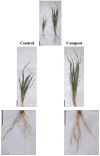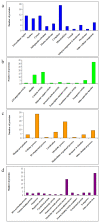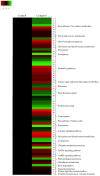Effects of Date Palm Waste Compost Application on Root Proteome Changes of Barley (Hordeum vulgare L.)
- PMID: 36771612
- PMCID: PMC9921465
- DOI: 10.3390/plants12030526
Effects of Date Palm Waste Compost Application on Root Proteome Changes of Barley (Hordeum vulgare L.)
Abstract
Proteomic analysis was performed to investigate the differentially abundant proteins (DAPs) in barley roots during the tillering stage. Bioinformatic tools were used to interpret the biological function, the pathway analysis and the visualisation of the network amongst the identified proteins. A total of 72 DAPs (33 upregulated and 39 downregulated) among a total of 2580 proteins were identified in response to compost treatment, suggesting multiple pathways of primary and secondary metabolism, such as carbohydrates and energy metabolism, phenylpropanoid pathway, glycolysis pathway, protein synthesis and degradation, redox homeostasis, RNA processing, stress response, cytoskeleton organisation, and phytohormone metabolic pathways. The expression of DAPs was further validated by qRT-PCR. The effects on barley plant development, such as the promotion of root growth and biomass increase, were associated with a change in energy metabolism and protein synthesis. The activation of enzymes involved in redox homeostasis and the regulation of stress response proteins suggest a protective effect of compost, consequently improving barley growth and stress acclimation through the reduction of the environmental impact of productive agriculture. Overall, these results may facilitate a better understanding of the molecular mechanism of compost-promoted plant growth and provide valuable information for the identification of critical genes/proteins in barley as potential targets of compost.
Keywords: barley; compost; differentially abundant proteins; proteome; qRT-PCR; roots.
Conflict of interest statement
The authors declare no conflict of interest.
Figures






Similar articles
-
Proteomic Analysis of Barley (Hordeum vulgare L.) Leaves in Response to Date Palm Waste Compost Application.Plants (Basel). 2022 Nov 29;11(23):3287. doi: 10.3390/plants11233287. Plants (Basel). 2022. PMID: 36501326 Free PMC article.
-
Date Palm Waste Compost Application Increases Soil Microbial Community Diversity in a Cropping Barley (Hordeum vulgare L.) Field.Biology (Basel). 2023 Apr 3;12(4):546. doi: 10.3390/biology12040546. Biology (Basel). 2023. PMID: 37106747 Free PMC article.
-
Identification of the differentially accumulated proteins associated with low phosphorus tolerance in a Tibetan wild barley accession.J Plant Physiol. 2016 Jul 1;198:10-22. doi: 10.1016/j.jplph.2016.03.016. Epub 2016 Apr 16. J Plant Physiol. 2016. PMID: 27111503
-
Comparative proteomics analysis of Tibetan hull-less barley under osmotic stress via data-independent acquisition mass spectrometry.Gigascience. 2020 Mar 1;9(3):giaa019. doi: 10.1093/gigascience/giaa019. Gigascience. 2020. PMID: 32126136 Free PMC article.
-
Function, Mechanism, and Application of Plant Melatonin: An Update with a Focus on the Cereal Crop, Barley (Hordeum vulgare L.).Antioxidants (Basel). 2022 Mar 25;11(4):634. doi: 10.3390/antiox11040634. Antioxidants (Basel). 2022. PMID: 35453319 Free PMC article. Review.
References
-
- Alkharabsheh H.M., Seleiman M.F., Hewedy O.A., Battaglia M.L., Jalal R.S., Alhammad B.A., Schillaci C., Ali N., Al-Doss A. Field crop responses and management strategies to mitigate soil salinity in modern agriculture: A review. Agronomy. 2021;11:2299. doi: 10.3390/agronomy11112299. - DOI
-
- FAOSTAT. 2020. [(accessed on 1 August 2022)]. Available online: https://www.fao.org/faostat/en/#data/QCL.
-
- Ho T.T.K., Tra V.T., Le T.H., Nguyen N.K.Q., Tran C.S., Nguyen P.T., Vo T.D.H., Thai V.N., Bui X.T. Compost to improve sustainable soil cultivation and crop productivity. Case Stud. Chem. Environ. Eng. 2022;6:100211. doi: 10.1016/j.cscee.2022.100211. - DOI
-
- Heisey S., Ryals R., Maaz T.M., Nguyen N.H. A single application of compost can leave lasting impacts on soil microbial community structure and alter cross-domain interaction networks. Front. Soil Sci. 2022;2:749212. doi: 10.3389/fsoil.2022.749212. - DOI
-
- Darimani H.S., Adams A., Abudul Rahaman A.B., Nwang J., Yunus R. Bio-compost as a soil supplement to improve growth and yield of tomato (Lycopersicum esculentum) J. Agric. Chem. Environ. 2022;11:67–82. doi: 10.4236/jacen.2022.112005. - DOI
LinkOut - more resources
Full Text Sources

